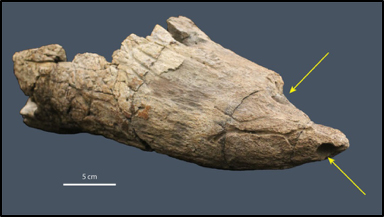By Alex Hastings, Assistant Curator of Paleontology, Virginia Museum of Natural History
Movies, television, and comic books have all depicted dinosaurs fighting each other many times. However, scientific evidence of live interactions between dinosaurs are exceptionally rare. Even in most cases of tooth marks on bone, it is impossible to tell whether or not the fossil represents predation or scavenging. These fossils become rarer still for the uncommon large predators of the dinosaur era. Feeding traces that can be attributed to Tyrannosaurus are incredibly uncommon. However, fossilization sometimes gives tantalizing clues of live interaction.

Above is the brow horn of an adult Triceratops (Fig. 1) from the Hell Creek Formation of Montana, from the end of the Age of the Dinosaurs (about 68 million years ago). The end of the horn is missing, and we may have a good clue as to why. Two very deep and large round depressions are featured at the remaining end, which match up perfectly with those of an adult Tyrannosaurus (Fig. 2). An associated fragment of the frill from the same individual also bears several tooth marks (Fig. 3), although these are admittedly harder to see in photographs. A series of tooth marks form a line across the frill. In X-ray, the location of these tooth marks is revealed to be denser than the bone around it, which indicates healing and bone regrowth. This is critical to understanding this interaction because it means the Triceratops lived through the encounter, and was therefore alive when the marks were made.
This fossil is the only evidence in the world for live interaction between Tyrannosaurus and Triceratops. Tooth marks have been found in other Triceratops bones, but these have never shown signs of healing. This fossil and only a handful of others are the best evidence out there that Tyrannosaurus was likely an active predator, and not an obligatory scavenger.
This fossil is part of a Hell Creek collection that was orphaned when the Shenandoah Valley Discovery Museum decided to no longer maintain scientific collections. This collection (including this Triceratops) is now part of the fossil collection at the Virginia Museum of Natural History in Martinsville, Virginia. Recent funds acquired from the Bureau of Land Management have allowed for the entire Hell Creek collection to be digitized. To see photos of these specimens check out the Virginia Museum of Natural History’s account at FLICKR.com
For more about this amazing fossil, please see the original publication by Dr. John Happ:
Happ, J. 2008. An analysis of predator-prey behavior in a head-to-head encounter between Tyrannosaurus rex and Triceratops, in P. Larson & K. Carpenter (eds.), Tyrannosaurus rex the Tyrant King, Indiana University Press, pp. 355–370.

